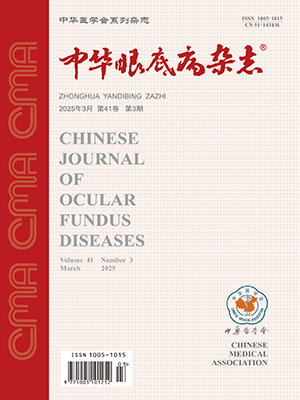| 1. |
Ahn SJ, Ryoo NK, Woo SJ. Ocular toxocariasis: clinical features, diagnosis, treatment, and prevention[J]. Asia Pac Allergy, 2014, 4(3): 134-141. DOI: 10.5415/apallergy.2014.4.3.134.
|
| 2. |
Wang H, Tao Y. Clinical features and prognostic factors in northern Chinese patients with peripheral granuloma type of ocular toxocariasis: a retrospective cohort study[J]. Ocul Immunol Inflamm, 2021, 29(7-8): 1259-1264. DOI: 10.1080/09273948.2020.1804592.
|
| 3. |
Martinez J, Ivankovich-Escoto G, Wu L. Pediatric ocular toxocariasis in costa rica: 1998-2018 experience[J]. Ocul Immunol Inflamm, 2021, 29(7-8): 1246-1251. DOI: 10.1080/09273948.2020.1792513.
|
| 4. |
Good B, Holland CV, Taylor MR, et al. Ocular toxocariasis in schoolchildren[J]. Clin Infect Dis, 2004, 39(2): 173-178. DOI: 10.1086/421492.
|
| 5. |
Arevalo JF, Espinoza JV, Arevalo FA. Ocular toxocariasis[J]. J Pediatr Ophthalmol Strabismus, 2013, 50(2): 76-86. DOI: 10.3928/01913913-20120821-01.
|
| 6. |
Badri M, Eslahi AV, Olfatifar M, et al. Keys to unlock the enigma of ocular toxocariasis: a systematic review and meta-analysis[J]. Ocul Immunol Inflamm, 2021, 29(7-8): 1265-1276. DOI: 10.1080/09273948.2021.1875007.
|
| 7. |
崔艳平. 彩色多普勒超声技术应用于诊断浅表小器官疾病的临床效果探讨[J]. 医学理论与实践, 2021, 34(5): 841-842. DOI: 10.19381/j.issn.1001-7585.2021.05.056.Cui YP. The clinical effect of color Doppler ultrasonography in the diagnosis of superficial small organ diseases[J]. J Med Theor & Prac, 2021, 34(5): 841-842. DOI: 10.19381/j.issn.1001-7585.2021.05.056.
|
| 8. |
董杰, 丁静文, 侯志嘉, 等. 先天性盲性小眼球超声影像学特征及眼轴长度分析[J]. 中华眼科杂志, 2021, 57(11): 825-829. DOI: 10.3760/cma.j.cn112142-20201118-00762.Dong J, Din JW, Hou ZJ, et al. Ultrasonic manifestations and axis length of blind microphthalmia[J]. Chin J Ophthalmol, 2021, 57(11): 825-829. DOI: 10.3760/cma.j.cn112142-20201118-00762.
|
| 9. |
朱春雾, 刘欣艳. 探究CT与MRI联合检查在肝硬化背景下肝脏良恶性结节鉴别诊断中的应用价值[J]. 影像研究与医学应用, 2021, 5(16): 127-128. DOI: 10.3969/j.issn.2096-3807.2021.16.058.Zhu CW, Liu XY. To explore the value of combined CT and MRI in the differential diagnosis of benign and malignant nodules of liver in the background of cirrhosis[J]. Journal of Imaging Research and Medical Applications, 2021, 5(16): 127-128. DOI: 10.3969/j.issn.2096-3807.2021.16.058.
|
| 10. |
Kwon SI, Lee JP, Park SP, et al. Ocular toxocariasis in Korea[J]. Jpn J Ophthalmol, 2011, 55(2): 143-147. DOI: 10.1007/s10384-010-0909-7.
|
| 11. |
Li S, Sun L, Liu C, et al. Clinical features of ocular toxocariasis: a comparison between ultra-wide-field and conventional camera imaging[J]. Eye (Lond), 2021, 35(10): 2855-2863. DOI: 10.1038/s41433-020-01332-w.
|
| 12. |
Hu XF, Feng J, Kang H, et al. Clinical characteristics of ocular toxocariasis in adults in north China[J]. Int J Ophthalmol, 2022, 15(3): 401-406. DOI: 10.18240/ijo.2022.03.05.
|
| 13. |
Pivetti-Pezzi P. Ocular toxocariasis[J]. Int J Med Sci, 2009, 6(3): 129-130. DOI: 10.7150/ijms.6.129.
|
| 14. |
Cortez RT, Ramirez G, Collet L, et al. Ocular parasitic diseases: a review on toxocariasis and diffuse unilateral subacute neuroretinitis[J]. J Pediatr Ophthalmol Strabismus, 2011, 48(4): 204-212. DOI: 10.3928/01913913-20100719-02.
|
| 15. |
Zhou M, Chang Q, Gonzales JA, et al. Clinical characteristics of ocular toxocariasis in Eastern China[J]. Graefe's Arch Clin Exp Ophthalmol, 2012, 250(9): 1373-1378. DOI: 10.1007/s00417-012-1971-2.
|
| 16. |
Kwon JW, Lee SY, Jee D, et al. Prognosis for ocular toxocariasis according to granuloma location[J/OL]. PLoS One, 2018, 13(8): e0202904[2018-08-30]. https://pubmed.ncbi.nlm.nih.gov/30161178/. DOI: 10.1371/journal.pone.0202904.
|
| 17. |
Despreaux R, Fardeau C, Touhami S, et al. Ocular toxocariasis: clinical features and long-term visual outcomes in adult patients[J]. Am J Ophthalmol, 2016, 166: 162-168. DOI: 10.1016/j.ajo.2016.03.050.
|
| 18. |
Campbell JP, Wilkinson CP. Imaging in the diagnosis and management of ocular toxocariasis[J]. Int Ophthalmol Clin, 2012, 52(4): 145-153. DOI: 10.1097/IIO.0b013e318265d58b.
|
| 19. |
刘敬花, 李松峰, 邓光达, 等. 儿童眼弓蛔虫病临床特点分析[J]. 中华实验眼科杂志, 2019, 37(5): 371-375. DOI: 10.3760/cma.j.issn.2095-0160.2019.05.011.Liu JH, Li SF, Deng GD, et al. Clinical characteristics of pediatric ocular toxocariasis[J]. Chin J Exp Ophthalmol, 2019, 37(5): 371-375. DOI: 10.3760/cma.j.issn.2095-0160.2019.05.011.
|
| 20. |
胡毅倩, 冯华章, 周秀莉, 等. 眼弓蛔虫病患眼B型超声图像分析[J]. 中国超声医学杂志, 2017, 33(7): 577-580. DOI: 10.3969/j.issn.1002-0101.2017.07.001.Feng YQ, Feng HZ, Zhou XL, et al. Ultrasonography findings in cases with ocular toxocariasis[J]. Chinese J Ultrasound Med, 2017, 33(7): 577-580. DOI: 10.3969/j.issn.1002-0101.2017.07.001.
|
| 21. |
Agarwal A, Das P, Kumar A, et al. Multiple granulomas of ocular toxocariasis in an immunocompetent male[J]. Ocul Immunol Inflamm, 2020, 28(1): 111-115. DOI: 10.1080/09273948.2019.1597895.
|
| 22. |
李肖春, 常青, 江睿, 等. 40例眼弓蛔虫病患者首诊临床特征分析[J]. 中华眼底病杂志, 2016, 32(1): 40-43. DOI: 10.3760/cma.j.issn.1005-1015.2016.01.010.Li XC, Chang Q, Jiang R, et al. Clinical characteristics of ocular toxocariasis patients on the first attendance[J]. Chin J Ocul Fundus Dis, 2016, 32(1): 40-43. DOI: 10.3760/cma.j.issn.1005-1015.2016.01.010.
|
| 23. |
Takkar B, Venkatesh P, Gaur N, et al. Patterns of uveitis in children at the apex institute for eye care in India: analysis and review of literature[J]. Int Ophthalmol, 2018, 38(5): 2061-2068. DOI: 10.1007/s10792-017-0700-6.
|
| 24. |
Abd El Latif E, Fayez Goubran W, El Gemai EEDM, et al. Pattern of childhood uveitis in egypt[J]. Ocul Immunol Inflamm, 2019, 27(6): 883-889. DOI: 10.1080/09273948.2018.1502325.
|
| 25. |
崔蕊, 李栋军, 王子杨, 等. 彩色多普勒超声在视网膜母细胞瘤诊断中的应用价值[J]. 中华医学超声杂志(电子版), 2017, 14(10): 725-729. DOI: 10.3877/cma.j.issn.1672-6448.2017.10.002.Cui R, Li DJ, Wang ZY, et al. Value of color Doppler ultrasonography in the evaluation of retinoblastoma[J]. Chin J Med Ultrasound (Electronic Edition), 2017, 14(10): 725-729. DOI: 10.3877/cma.j.issn.1672-6448.2017.10.002.
|
| 26. |
陈伟, 李栋军, 王子杨, 等. 彩色多普勒血流显像对永存原始玻璃体增生症诊断的敏感度和特异度[J]. 中华眼底病杂志, 2016, 32(3): 296-299. DOI: 10.3760/cma.j.issn.1005-1015.2016.03.016.Chen W, Li DJ, Wang ZY, et al. Diagnostic sensitivity and specificity of color Doppler flow imaging for persistent hyperplastic primary vitreous[J]. Chin J Ocul Fundus Dis, 2016, 32(3): 296-299. DOI: 10.3760/cma.j.issn.1005-1015.2016.03.016.
|




